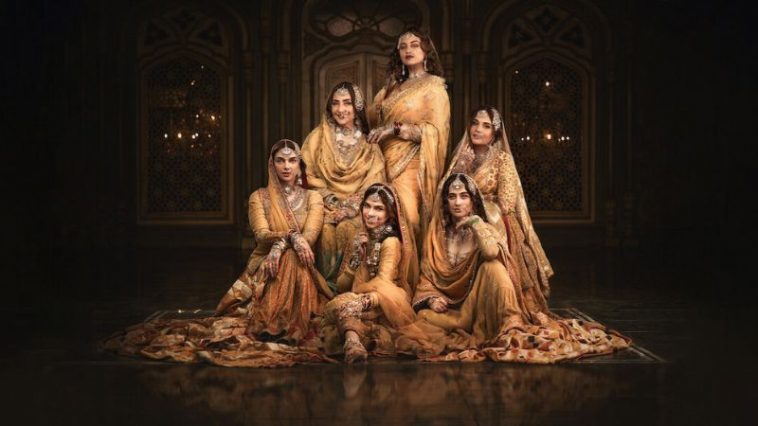At various points in “Heeramandi” – Sanjay Leela Bhansali’s eight episode epic now streaming on Netflix – a master shot of a heeramandi street captures a stunning snapshot of a typical evening in the fabled market; Vintage cars carrying entitled nawabs jostle for space with horse-drawn carriages; exquisite kothas line the street looking slender and tempting; and finally, dancing girls are seen spinning around on the kotha terraces and inside the well-lit rooms, seen only through the huge windows. The street feels like a bustling shopping market, each kotha a shop, with a live-action window display, teasing what all can be bought inside.
All this is great, except that the series, “Heeramandi”, too, feels like window-dressing. Adorned and arranged so painstakingly, to bedazzle the viewers. The viewers would have been bewitched enough to buy it, but only if it was a two-hour feature film and not an eight-hour long bludgeoning web-series. Sanjay Leela Bhansai, who directed, produced, edited and co-wrote the series, has his stamp all over it. Each frame is a painting; the costume and jewelry are regal; the sets are opulent; the women are larger-than-life, looking majestic even as they laze around in bed; drama borders on melodrama; Urdu isn’t spoken, it’s delivered; history is spectacularly fictionalized; and moments make the story, not vice versa.
But the relentless beauty can only sustain a movie, and not a long-form episodic drama. Some inspired touches can transport the viewer but for only a second. Bhansali’s soft spots, grudging visible in his last four feature films, are on full display in “Heeramandi”. Key elements that make or break a series like plot and character development, pacing, and narrative progression falter here. There is too much plot but conflict never really goes above room-temperature. It is a shame, because the world of heeramandi in the pre-independence Lahore was anything but cold.
The story focuses on a family of courtesans led by the formidable Mallikajaan (Manisha Koirala). She has no boundaries between home and work and rules over her sisters and daughters with the same iron rod as other tawaifs and servants working in her kotha. Her sister Waheeda (Sanjeeda Sheikh) is miserable of playing second fiddle to her elder sister and in one scene waxes eloquent about the long list of her defeats. Mallikajaan’s older daughter Bibbojan (Aditi Rao Hydari) is a compliant courtesan and a secret independence rebel. The youngest daughter, Alamzeb (Sharmin Segal) is yet to have her nath utrai – first mujra of a tawaif – and falls in love with a scion of a nawab family, Tajdar Baloch (Taha Shah).There is also Fareedan (Sonakshi Sinha) , a rival courtesan hell bent on seeking revenge from Mallikanjan.
The story blends kotha culture, vengeance, blossoming love and independence struggle, threading it all through Mallikajaan and her kotha. The nawabs, the only ones who can afford her services are the patrons keeping the heeramandi business afloat after the British takeover of Lahore starts to blemish the centuries-old courtesan culture and prestige that the Mughals had built. The nawabzadas are shown to be vain and incredulously gullible, used and abused by the seductive and shewed courtesans.
Manisha Koirala’s magnetic turn desperately tries to uplift the conflict, which at times, feels like an Indian soap version of a tawaif catflight. Sonakshi SInha has a scene-chewing presence but only gets an artfully choreographed ‘Tilasmein Bahein’ that does justice to her talent.
But perhaps the biggest letdown is the central love story of “Heeramandi”, between Alam and Taj. It features Bhansali’s weakest love-at-first-sight encounter between the lovers. Taha Shah brings a boyish charm to his rebellious nawab Tajdar but Sharmin Segal as Alam is almost robotic in her turn as a girl trying to break out of the chains of heeramandi. She has one expression for every emotion that doesn’t even allow for eye contact with her fellow actors. The lifeless performances infuse “Heeramandi” with a barrenness which is ironic because Bhansali’s frames have never looked so full and yet feel vacant.
The last three episodes feel rushed, with the screenplay moving characters around like chess pieces, wherever it needs them to be. Characters have an unbelievably quick change of heart and even if the climax appears soul-stirring, it’s just the senses that are momentarily shaken.
It is 1945 Lahore, the independence struggle is in full swing and yet there is not even a single mention of a Muslim leader leading a fight against the British (not even Pro Congress Muslim leaders like Abul Kalam Azaad). The idea of Pakistan is absent altogether. It is one thing to avoid communalism in a saga about courtesans, but erasing it altogether is playing it too safe. But it is still great that in this day and age, a series now exists which is based on Muslim characters that aren’t, for once, terrorists.
Bhansali works to death to insert an emotional core, something he successfully managed in a flawed but moving “Gangubai Kathiwadi” but there is nothing in “Heeramandi” and its tawaifs to make the heart leap. Despite some stellar performances, it remains a glorified cosplay. Clearly, beautifully ornamented nostalgia can only do so much.



Comments
0 comments